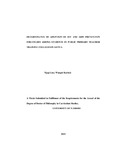| dc.description.abstract | HIV prevalence is high among young adults. Students in colleges lead a liberal life and continue to engage in risky sexual behaviours mostly without HIV protection. This study, therefore, investigated determinants that influence students in adoption of HIV and AIDS prevention strategies. Data were collected on students’ social-demographic characteristics, knowledge levels on HIV, sexual behaviours and perceived risk to HIV infection. A cross-sectional correlational descriptive survey design was used. Using a national list of 20 public teacher training colleges, a random sample of 13 colleges was selected. Two second year classes of about 40 students were selected using simple random sampling method that utilized single stage cluster design. A total sample of 1,040 students was drawn. In addition, 12 discussants from each selected college were systematically sampled to participate in focus group discussions. In addition, 13 deans of tudents and 13 principals were interviewed. Descriptive statistics were generated for all survey items using Statistical Package for Social Sciences computer
programme version 17. Chi-square test was used to test each hypothesis using alpha .05 as the level of statistical significance. Multiple regression analysis was conducted to identify predictors of adoption of HIV prevention strategies. Findings indicated that of the three effective strategies; abstinence was difficult to
achieve with students, slightly more students practised fidelity and condom use was the most popular. Socio-demographic characteristics such as gender and religion were significantly related to adopted HIV strategies but the associations were weak. There was a positive weak association between HIV knowledge and HIV prevention strategies. No significant relationship was found between students’ sexual behaviours and perceived risk to HIV and HIV prevention strategies separately. Group discussants believed that sex with multiple partners
was a ‘lifestyle’ that had persisted in colleges because of the belief that college life is a time of 'exploration and experimentation’. It was concluded that gender and religion continue to be important factors in scaling down the pandemic; knowledge about HIV was necessary but by itself not sufficient to make students adopt prevention strategies. There was also a risk of students contracting HIV because of the poor assessment of personal risk to HIV. It was recommended that tutors be developed to clear HIV misconceptions; a surveillance system to track
HIV prevalence in college be developed; and life skills education be made an examinable subject. | |

